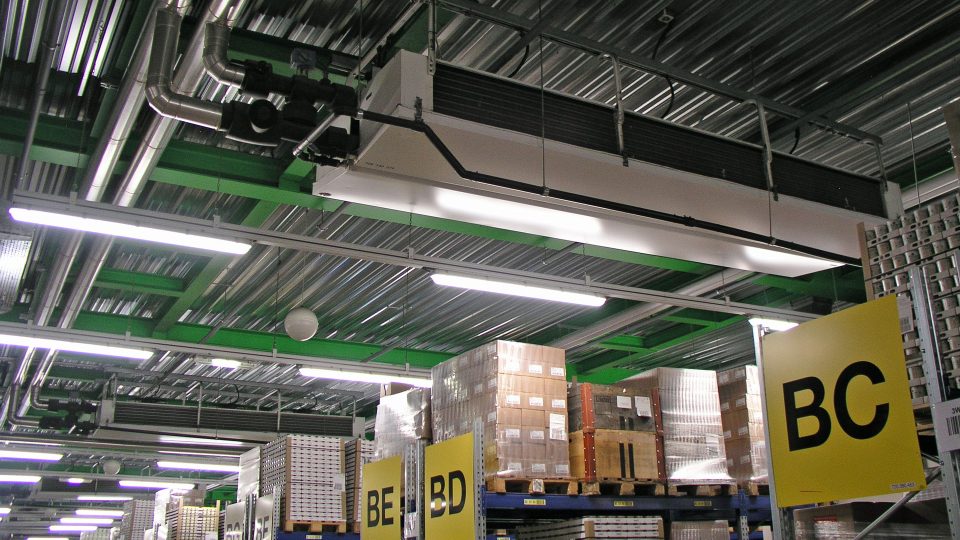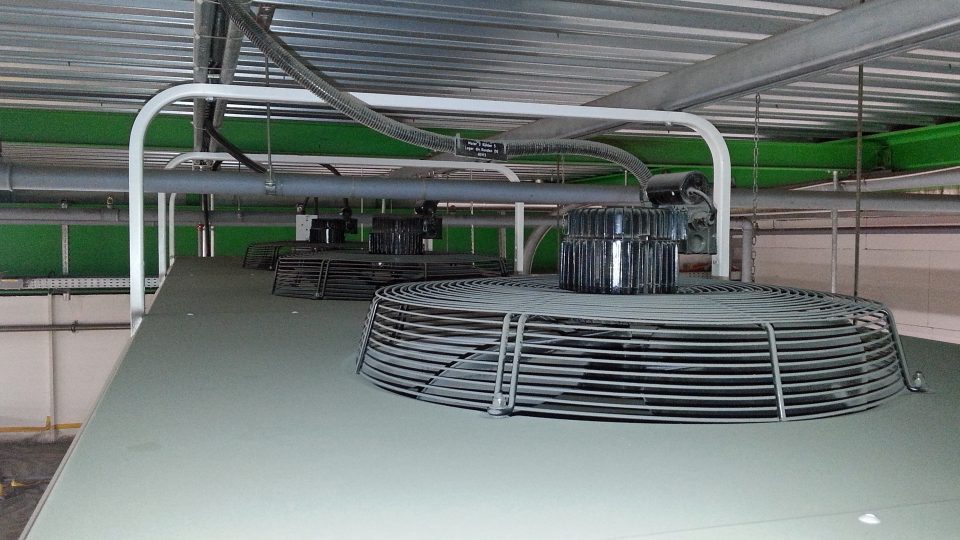Matthias Künzli is actually a specialist in automation at dairy processor Emmi in Suhr, Switzerland. However, in recent months, he has been working hard on another topic, one that is close to his hard: Modernizing the warehouse cooling system in the logistics center to make it more energy efficient. “It has been in operation for more than 20 years. It was therefore clear that failures and repairs would occur more frequently in the future. Aside from that, the entire system was simply no longer up to date,” he explains.
This is also due to the fact that, until a few years ago, in addition to dairy products, meat, eggs and vegetables were stored and picked at the logistics site in Suhr. “Colder ambient temperatures are required for these products. As a result, the cooling capacity of the fans was primarily designed for this,” says Künzli. In recent years, the Suhr site has been expanded to become a center of excellence for milk and butter. “More precisely, liquid and fat,” explains Künzli.

A retrofit for demand-based cooling
At Emmi, sustainability has always played a key role and is also firmly anchored in the corporate strategy. Based on its sustainability model and a net zero reduction path, Emmi has set ambitious and scientifically supported targets for reducing greenhouse gas emissions. By 2027, it wants to reduce its own emissions (Scopes 1 and 2) by 60 percent. Energy efficiency is an important issue here. “We have been working on energy optimization across all the media for over ten years: steam, water, gas, electricity, everywhere there are developments that help us to save,” says Künzli. “With electricity, the easiest way to determine the savings is by doing a before/after measurement. This is why modernization projects in this area can also be easily conveyed to management.”
We have been working on energy optimization across all the media for over ten years. With electricity, before/after measurement is easiest, so modernization projects are easy to convey.
Matthias Künzli, specialist in automation at EMMI
Matthias Künzli got to work and looked at the existing fans more closely. “I was shocked by the number of installed fans and their joint power. We no longer need this power when using the logistics center, but could not reduce it because it is not so easy to adjust the speed of the old fans,” he explains. “In addition, the AC fans had very poor efficiency levels anyway.” Time for a comprehensive retrofit!

No such thing as no can do
Matthias Künzli did not make things easy for himself. He meticulously refined his list of installed fan types, performed consumption measurements, compared performance classes and volume flow rates and looked for partners to retrofit cooling units with energy efficiency. “I wanted state-of-the-art fans to be installed in existing devices,” he says. “The ceiling coolers are very robust and have few wearing parts. It is simply not sustainable to throw them away.”
But most of the refrigerator manufacturers he asked recommended exactly this approach. When Künzli attended a seminar by ebm-papst in 2020, he was enthusiastic about the performance of modern EC fans, and also by the commitment of the employees at the ebm-papst subsidiary in Switzerland. “They helped me with my project right from the start. There was no ‘that isn’t possible’,” says Künzli, who decided to retrofit his cooling system with fans from ebm-papst.

Good planning pays off

As the retrofit was going to be performed during operation, Matthias Künzli left nothing to chance during the preliminary planning. Together with his deputy Arber Gashi, he disassembled one of every cooler type and equipped it with a fan from ebm-papst. “It was important that the cooling units were quickly ready for use again. The aim was also to determine which brackets were necessary to attach the new fans to the existing ceiling cooler. I had them made in advance,” says Künzli.
It all started at the beginning of 2023: Nine coolers were each equipped with three AxiEco axial fans with guard grills for short nozzles. And 27 others, each with three HyBlade axial fans. Both versions make a great impression, not only with their low energy requirements, but also with their shallow installation depth, low noise level and excellent efficiency. Measurements shortly after installation show that the current draw per cooler has fallen from eight amperes to one ampere.
“We currently operate the fans via setpoint potentiometers with 50 percent power,” says Künzli. “If the maximum power requirement is determined in summer, the individual cooling units in the final assembly can then be individually controlled via setpoints from the PLC.”
Energy savings of over 80 percent
In addition to the smooth conversion, Matthias Künzli is particularly pleased about the measurable result of the retrofit: “ebm-papst promised us energy savings of around 50 percent. In fact, most fans give us more than 80 percent. Thanks to the fans’ efficiency, the 50 percent savings – and up to 30 more – mean that we have been able to generally reduce the fan power.”
But it is not just the numbers that have inspired Künzli. “The new fans hardly make a sound. I had to take a look at the visualization to see if they were actually running,” he says with a smile. “At the logistics center, we have a loudspeaker system that plays background music and messages during working hours. It can now finally be heard really well. That is good news for our employees.” After the retrofit, it has also been more pleasant for them, Künzli adds: “Before, we distributed the cooled air via textile hoses in the hall. It was time-consuming and generated an air draft. But now the employees almost no longer feel it. We may consider removing the textile hoses completely in some areas.”
ebm-papst promised us energy savings of around 50 percent. In fact, most fans give us more than 80 percent.
Matthias Künzli, specialist in automation at EMMI
Two floors were fitted with new fans in the four-story logistics center by March 2023. The 21 coolers in the basement are still to come, with another 78 fans. “We can only perform the replacement in winter 2024 because we have to rely on cool ambient temperatures again,” says Matthias Künzli, who is already looking forward to it. “When the entire project is completed in spring 2024, we will have a total of 206 new fans in operation and, according to current calculations, save around 550,000 kilowatt hours of electricity per year.” That is around 200 metric tons of CO2.



Leave a comment